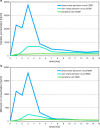Hypoxic Isolated Abdominal Perfusion (HAP) chemotherapy for non-operable advanced staged ovarian cancer with peritoneal carcinosis: an experience in 45 platinum-refractory ovarian cancer patients
- PMID: 31496601
- PMCID: PMC6707993
- DOI: 10.1007/s13193-019-00922-9
Hypoxic Isolated Abdominal Perfusion (HAP) chemotherapy for non-operable advanced staged ovarian cancer with peritoneal carcinosis: an experience in 45 platinum-refractory ovarian cancer patients
Abstract
In order to break through drug resistance in platinum-refractory ovarian cancer, augmented drug exposure was administered to the abdomen by means of an isolated perfusion system. Four cycles of isolated hypoxic abdominal perfusion with cisplatin, adriamycin, and mitomycin were conducted in 4-week intervals. Cisplatin and adriamycin were chosen because of their increased cytotoxicity under hypoxic conditions. Chemofiltration was performed for prophylaxis of cumulative toxicity of adriamycin and mitomycin. The study included 45 patients with recurrent epithelial ovarian cancer who had prior platinum containing therapies (3, stage Federation of Gynecology and Obstetrics (FIGO) IIIB; 20, stage FIGO IIIC; 22; stage FIGO IV). The median survival rate in stage FIGO IIIBC was 12 months, and in stage IV was 10 months. The tumor marker decreased to complete response or partial response at 17.8% and 55.6% of the patients. CT or MRI visualization showed complete response in 4.1%, and partial response was in 54.1%. Complete resolution of ascites was noted in 30% of cases and substantial reduction in another 43%. Toxicity was generally low. Quality of life was improved in the majority of cases. Bone-marrow suppression ranged between WHO grade 1 and 2, and in patients with previous third- or fourth-line chemotherapy, it was WHO grade 3. Isolated hypoxic abdominal perfusion with chemofiltration for patients with progressive and platinum-refractory stage III and IV ovarian cancer is an effective therapy, breaking through chemoresistance and offering comparably long survival at good quality of life.
Keywords: Chemoresistance; Intra-arterial chemotherapy; Isolated abdominal perfusion; Ovarian cancer; Quality of life.
Conflict of interest statement
Conflict of InterestThe authors declare that they have no conflict of interest.
Figures





Similar articles
-
Hypoxic isolated abdominal perfusion breaks through chemoresistance in recurrent FIGO stage IIIC and IV ovarian cancer.Mol Clin Oncol. 2021 Jun;14(6):129. doi: 10.3892/mco.2021.2291. Epub 2021 Apr 27. Mol Clin Oncol. 2021. PMID: 33981433 Free PMC article.
-
Neoadjuvant chemotherapy followed by tumor debulking prolongs survival for patients with poor prognosis in International Federation of Gynecology and Obstetrics Stage IIIC ovarian carcinoma.Cancer. 2001 Nov 15;92(10):2585-91. doi: 10.1002/1097-0142(20011115)92:10<2585::aid-cncr1611>3.0.co;2-#. Cancer. 2001. PMID: 11745193 Clinical Trial.
-
Abdominal stop flow infusion breaks drug resistance in systemically pretreated progressive FIGO IIIc and IV ovarian cancer.Gan To Kagaku Ryoho. 1998 Jan;25(1):111-4. Gan To Kagaku Ryoho. 1998. PMID: 9464336 Clinical Trial.
-
Medical therapy of advanced malignant epithelial tumours of the ovary.Forum (Genova). 2000 Oct-Dec;10(4):323-32. Forum (Genova). 2000. PMID: 11535983 Review.
-
[Surgery for advanced stage ovarian cancer: Article drafted from the French Guidelines in oncology entitled "Initial management of patients with epithelial ovarian cancer" developed by FRANCOGYN, CNGOF, SFOG, GINECO-ARCAGY under the aegis of CNGOF and endorsed by INCa].Gynecol Obstet Fertil Senol. 2019 Feb;47(2):197-213. doi: 10.1016/j.gofs.2019.01.003. Epub 2019 Feb 19. Gynecol Obstet Fertil Senol. 2019. PMID: 30792175 Review. French.
Cited by
-
Successful secondary radical operation on unretractable metastatic platinum-sensitive recurrent ovarian cancer by immunotherapy: a case report.Ann Transl Med. 2022 Jun;10(12):718. doi: 10.21037/atm-22-2128. Ann Transl Med. 2022. PMID: 35845511 Free PMC article.
-
Tumor response and the quality of life after isolated hypoxic pelvic perfusion for advanced G3 cervical cancer: A case series.Int J Surg Case Rep. 2020;77:816-821. doi: 10.1016/j.ijscr.2020.11.050. Epub 2020 Nov 25. Int J Surg Case Rep. 2020. PMID: 33395903 Free PMC article.
-
A Pilot Study of the Predictive Potential of Chemosensitivity and Gene Expression Assays Using Circulating Tumour Cells from Patients with Recurrent Ovarian Cancer.Int J Mol Sci. 2020 Jul 7;21(13):4813. doi: 10.3390/ijms21134813. Int J Mol Sci. 2020. PMID: 32646060 Free PMC article.
-
Arterial Infusion and Isolated Perfusion in Combination with Reversible Electroporation for Locally Relapsed Unresectable Breast Cancer.Cancers (Basel). 2024 Nov 28;16(23):3991. doi: 10.3390/cancers16233991. Cancers (Basel). 2024. PMID: 39682178 Free PMC article.
-
Regional Chemotherapy Is a Valuable Second-Line Approach in Metastatic Esophageal Cancer after Failure to First-Line Palliative Treatment.Curr Oncol. 2022 Jul 11;29(7):4868-4878. doi: 10.3390/curroncol29070386. Curr Oncol. 2022. PMID: 35877246 Free PMC article.
References
LinkOut - more resources
Full Text Sources
